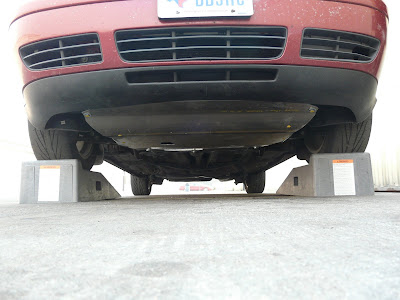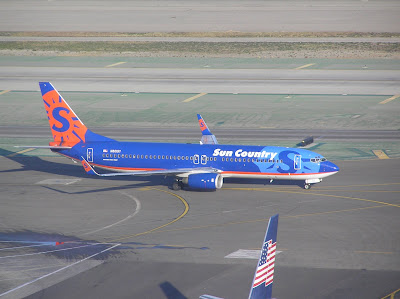 You've probably heard of the Thanksgiving ritual wherein this year's turkey receives a pardon from the president and gets to live happily ever after. This practice began in 1989 with the first President Bush. At first, the pardoned turkeys went to Kidwell Farm petting zoo at Frying Pan Park in Herndon,Virginia. Since 2005, however, the turkeys (there are actually two: the turkey, and an alternate, just in case of . . . whatever) have been flown to Disneyland, where they serve as honorary grand marshals in Disneyland's Thanksgiving Day parade. After the festivities, they become permanent residents at a Disneyland ranch. This year's turkeys, dubbed 'Pumpkin' and 'Pecan', came from Ellsworth, Iowa. After receiving their last-minute reprieve on Wednesday, the two lucky birds caught United flight 209 for their west-bound flight. Through the collaboration of the FAA, United used the callsign "United Turkey One" for this flight. The flight arrived about 5:30 pm, giving the birds plenty of time to rest up for their parade appearance the next morning.
You've probably heard of the Thanksgiving ritual wherein this year's turkey receives a pardon from the president and gets to live happily ever after. This practice began in 1989 with the first President Bush. At first, the pardoned turkeys went to Kidwell Farm petting zoo at Frying Pan Park in Herndon,Virginia. Since 2005, however, the turkeys (there are actually two: the turkey, and an alternate, just in case of . . . whatever) have been flown to Disneyland, where they serve as honorary grand marshals in Disneyland's Thanksgiving Day parade. After the festivities, they become permanent residents at a Disneyland ranch. This year's turkeys, dubbed 'Pumpkin' and 'Pecan', came from Ellsworth, Iowa. After receiving their last-minute reprieve on Wednesday, the two lucky birds caught United flight 209 for their west-bound flight. Through the collaboration of the FAA, United used the callsign "United Turkey One" for this flight. The flight arrived about 5:30 pm, giving the birds plenty of time to rest up for their parade appearance the next morning.  Another recent noteworthy arrival was the Japanese Prime Minister, who stopped at LAX on the way to and from the APEC meeting in Lima, Peru, last weekend. We also had, I believe, the President of South Korea pass through on his way home. The flight from Lima to LAX is about eight hours, and they stopped here to refuel and refresh before continuing the twelve or thirteen hours across the Pacific. On a personal note, this is the second time I've gotten to work Japanese Airforce Zero Zero One (and Two: the prime minister travels with a spare 747!) The first time was a couple of years ago in Memphis, Tennessee, when the Japanese prime minister came to visit Graceland. President Bush came to town too, but I forget the occasion for them being in Memphis. I do remember being chagrined that the Japanese prime minister's planes had much better sounding radios than the president's.
Another recent noteworthy arrival was the Japanese Prime Minister, who stopped at LAX on the way to and from the APEC meeting in Lima, Peru, last weekend. We also had, I believe, the President of South Korea pass through on his way home. The flight from Lima to LAX is about eight hours, and they stopped here to refuel and refresh before continuing the twelve or thirteen hours across the Pacific. On a personal note, this is the second time I've gotten to work Japanese Airforce Zero Zero One (and Two: the prime minister travels with a spare 747!) The first time was a couple of years ago in Memphis, Tennessee, when the Japanese prime minister came to visit Graceland. President Bush came to town too, but I forget the occasion for them being in Memphis. I do remember being chagrined that the Japanese prime minister's planes had much better sounding radios than the president's. Some unfinished business:
 Previously mentioned, but not shown: a Skywest CRJ-900 operated for Delta. This route to Salt Lake City is the only Delta/Skywest we have at LAX. Mainline Delta also flies the route, usually with B757's or MD90's. With the demise of Express Jet earlier this year, this is also now the only Delta Connection service seen at LAX.
Previously mentioned, but not shown: a Skywest CRJ-900 operated for Delta. This route to Salt Lake City is the only Delta/Skywest we have at LAX. Mainline Delta also flies the route, usually with B757's or MD90's. With the demise of Express Jet earlier this year, this is also now the only Delta Connection service seen at LAX. A US Coast Guard helicopter arrives at LAX. There are four USCG Dauphins based here - for now. The airport long-term plan calls for them to be relocated to make space for terminal and taxiway expansion.
A US Coast Guard helicopter arrives at LAX. There are four USCG Dauphins based here - for now. The airport long-term plan calls for them to be relocated to make space for terminal and taxiway expansion.And now, time for a couple of updates:
In the post about state capitals, I said that I had not recently noticed the United/Skywest flight to Oklahoma City. This past Saturday, I worked that flight on Ground Control, so it's still operating, and it's still in a CRJ-700.
In an earlier post about the A380, I said that LAX had four gates that could accommodate the jumbo Airbus. We now have six: Two at the International Terminal, and four of the remote gates at the west end of the airport.
As hoped for, the American Eagle Saabs have disappeared from the LAX scene. They all flew out in the course of the first week of November. So far, they've not been replaced with anything else; their routes are either being serviced with E135's or no longer being flown. I don't think we've gotten more E135's either, so flight frequency has probably been trimmed.
 The American Eagle terminal at LAX, referred to by controllers and pilots as "the Eagles Nest", or just "the nest". The good news: no Saabs! The bad news: awful lot of empty gates.
The American Eagle terminal at LAX, referred to by controllers and pilots as "the Eagles Nest", or just "the nest". The good news: no Saabs! The bad news: awful lot of empty gates.This facility too will go away under the LAX long-term plan.

Note: I didn't make up the stuff about the turkeys. See this:
http://www.infoplease.com/spot/tgturkey2.html






























































